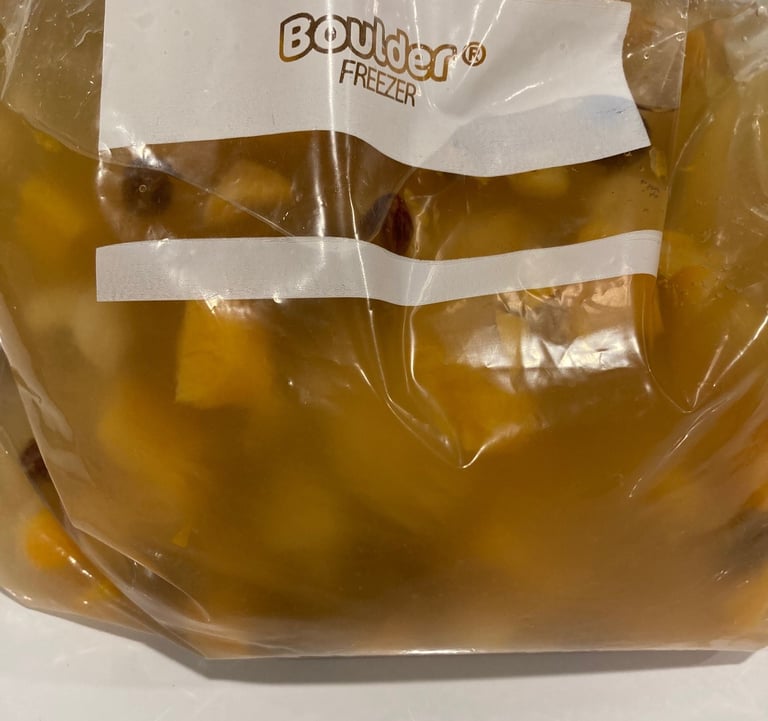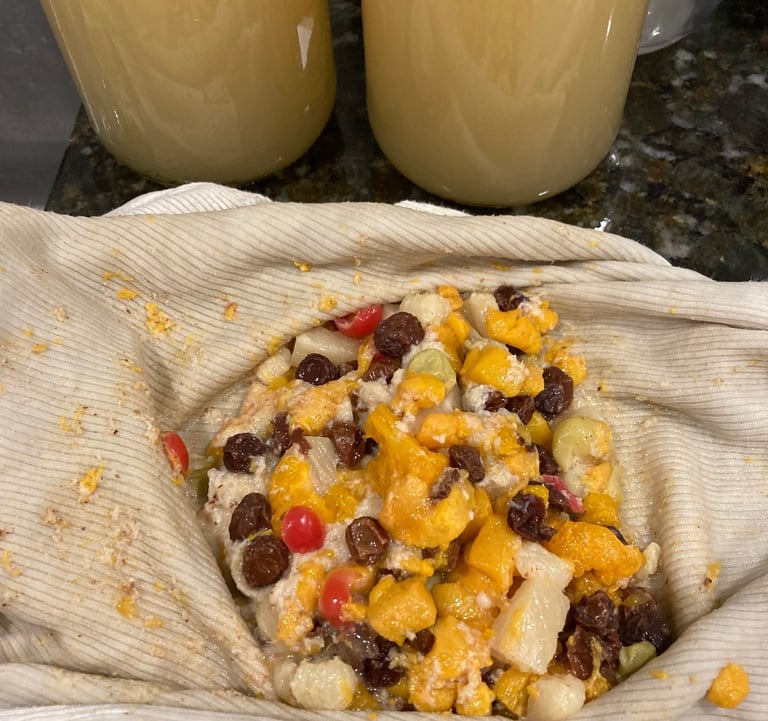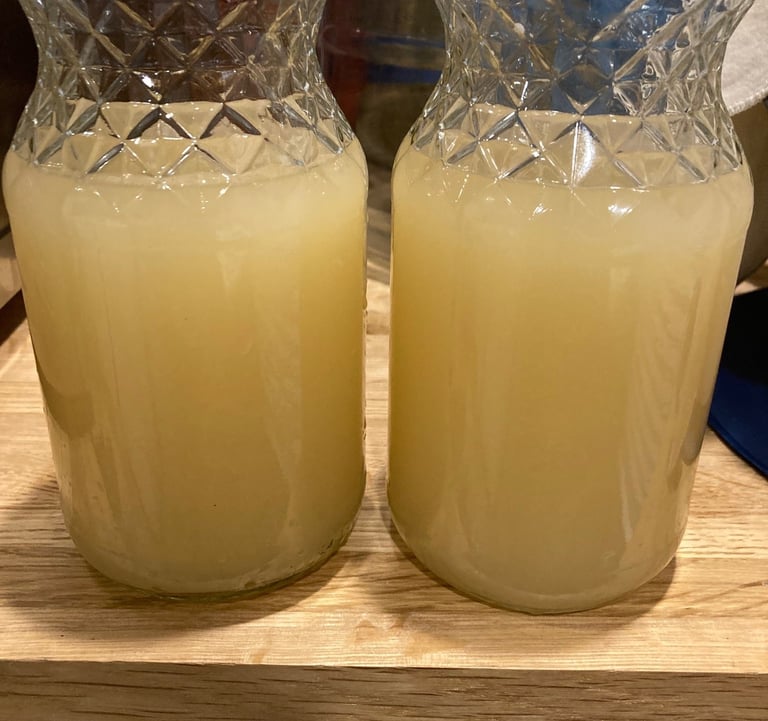Prison Hooch
I was doing a little internet search for more non-traditional winemaking methods and recipes recently when I came across an article on prison wine (also known as hooch, buck, pruno, and many others I'm sure) and decided to give it a shot. For some real-life experience I leaned on my son-in-law Adam, who was formerly a guard with the state prison system. As is the case outside the prison population, the list of winemaking ingredients is limited only by access and imagination. In his experience the best (relatively speaking) prison wines were made from cookies or raisins that were, ironically enough, brought in by church missions teams. However, as prison survival requires a certain level of resourcefulness, prison buck (the prevailing term in SC correctional facilities) was also made from pretty much anything that could be stolen from the kitchen or hoarded in sufficient quantities from meals or the commissary. This variety ranged from honey buns, Little Debbie cakes, apples, oranges, apple sauce, and even jams and jellies on the upper end of the spectrum to ketchup and onions on the more desperate end of the scale. Of course, sugar and yeast are required for fermentation, so additional sugar (also liberated from the kitchen or dining hall) in cube or packet form was added to the mix, and if bread yeast wasn't available in packet form a slice of white bread could be tossed into the mix. Apparently baking in an oven at 400 degrees doesn't kill all the yeast cells, a fact I can attest to after this experiment. All this is mixed together in any container available, from a trash bag to a tin can. For purposes of good hygiene and to be able to see the fermentation at work I used a gallon sized ziplock bag, but in prison the main factors would be availability and concealment capability, since alcohol is most definitely high on the contraband list. As with any active fermentation a tightly sealed container would not be advisable, as the CO2 produced by the fermentation process would cause quite a stir when the pressure caused the container to explode. I left about a half-inch of the bag unzipped to allow the gas to escape without attracting the attention of the guards.
For my concoction I wanted to hold to a few criteria to ensure at least a touch of accuracy, so I used only ingredients and equipment that could be obtained, either at meals or by theft, from a prison kitchen. Because I wanted to have a control, I also made a batch of wine using the same basic ingredients, but incorporating standard winemaking equipment and techniques. The basic prison wine recipe I used is as follows:
1 - 15oz can of fruit cocktail
50 sugar packets (approximately 1/2 lb of sugar)
2 Clementines (peeled and squeezed) to add sugar and acidity
2 small boxes of raisins (I did cut these in half, figured a shank would be available in the joint to facilitate this task)
1 slice white bread
For the process, I added all the ingredients to the ziplock bag, added about a quart and a half of hot water, sealed the bag completely, mashed the fruit as best I could to ensure the sugar dissolved and everything was mixed thoroughly, then added the bread. As mentioned, I left a small opening to allow for off-gassing, but after the first day I did seal the bag completely for a while to see how well the fermentation was progressing. The bag was bulging within a couple hours so I was confident the surviving bread yeast was doing it's thing. Every day for the first week I squeezed the bag to re-mix and allow some oxygen into the must (important reminder: seal the bag completely before squeezing!) but otherwise just left it alone. I estimated this mixture would yield maybe a half-gallon of finished product, with an alcohol content close to 10%. I may back-sweeten after tasting, but the ultimate purpose of this concoction is to get buzzed, so a more efficient use of limited sugar resources in the big house would be to save it up and start another batch!
For the control, I used the following recipe for a 1-gallon batch:
3 - 15oz cans of fruit cocktail
4 cups sugar (approx. 2 lbs)
1/4 cup raisins, chopped
1 tsp yeast nutrient
1 tsp acid blend
1/2 packet Lalvin 71B wine yeast
The process for this batch is pretty much my standard process for any country wine. Sanitize all the equipment, dissolve the sugar, mix the ingredients, let cool to 75 degrees or so, then add the yeast. Fermentation was evident that same evening. I didn't use Clementines in the control batch because I added acid blend and didn't need additional sugar. As is my usual process, I stirred the must every day for the first 4-5 days, then racked after a week. Maybe should've allowed longer in the primary, it was still fermenting well in the secondary, but it will work just fine this way. If fermented completely dry this will end up at around 12.5% ABV, and I will almost certainly stabilize and back-sweeten after it clears, taste dependent, of course.
Back to the hooch, after 2 weeks in the ziplock bag I strained the wine into 2 quart glass jars. Maybe glass isn't completely prison-authentic, but I didn't have any plastic soda bottles handy. However, in true prison style I strained it through a white wife-beater t-shirt; clean of course, I'm not a barbarian! The yield was indeed a little less than 2 quarts, and of course it was fairly cloudy, which is to be expected. A few pictures of the process are below. The initial taste test was somewhat less than gratifying to say the least. I had expected a hint of tropical or citrus notes given the ingredients, but it did not deliver on that. It certainly contained alcohol, so it did fulfill the main purpose, but the taste was reminiscent of kerosene mixed with sugar-free Kool-aid and long-expired cough syrup, not exactly my preferred flavor profile. My intent is to age both the hooch and the control batch for another month or so and taste again. Maybe taste both as they sit and then sweeten each a little just to see if it helps. Stay tuned for updates.





